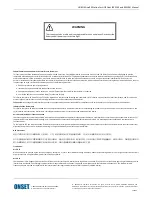
HOBO MicroRX Station for HOBOnet (RX2105 and RX2106) Manual
1-800-LOGGERS
14
www.onsetcomp.com
channel with a small amount of silicone grease. Route the
external solar panel cable through far-left hole in the cable
channel.
Guidelines for Deploying HOBOnet Wireless Motes
•
Stay close to the station when adding motes to the
wireless network because you will need to access both the
station and the mote at the same time. After the mote has
successfully joined the wireless network, you can then
move it to its deployment location.
•
Check the signal strength on the mote LCD at the location
where you want to place the mote. If there is only one or
two bars on the signal strength indicator, consider moving
the mote to a location where the signal strength is
stronger.
•
Consider using a plastic pole such as PVC to mount the
motes.
•
When deploying motes outdoors, make sure motes are
mounted a minimum of 1.8 m (6 feet) above the ground or
vegetation to help maximize distance and signal strength
as shown below.
•
When deploying motes outdoors, make sure each sensor
mote and repeater is positioned so that the built-in solar
panel receives optimal sunlight throughout each season as
shown. It may be necessary to periodically adjust the mote
position as the path of the sunlight changes throughout
the year or if tree and leaf growth alters the amount of
sunlight reaching the solar panel.
•
Obstructions between motes can prevent reliable network
communication. If the mote is blocked by a small
obstruction (e.g. a pole, the station, shrubbery), then
move the mote to a location where the obstruction is not
blocking the path to the nearest mote. If there is a large
obstruction in the way (e.g. a wall, building, or tree) or a
change in elevation between motes, then either reposition
the mote until there is full line of sight to the next mote or
add a repeater between them. The following diagram
shows an example of using a repeater in an outdoor
environment.
•
There should not be more than five motes in any direction
at their maximum transmission range from the station.
Data logged by a wireless sensor must travel or “hop”
across the wireless network from one mote to the next
until it ultimately reaches the station. To make sure the
data can successfully travel across the network, the mote
should not be more than five hops away from the station.
•
The HOBOnet wireless network can support up to 50
wireless sensors or 336 data channels per one HOBO RX
station.
•
Use the Map feature in HOBOlink for a bird’s eye view of
the network and wireless paths. See the HOBOlink Help
for details on this and other ways to monitor the status of
your network and sensor data.
•
Use cable ties or screws to mount the mote via the holes
on the mounting tabs.
•
Make sure the mote remains in a vertical position once it
is placed in its deployment location for optimal network
communications.
•
Make sure the mote door is closed, with both latches fully
locked to ensure a watertight seal in outdoor
environments and to protect it in indoor environments.
•
Consider using a 3/16 inch padlock to restrict access to the
mote. With the mote door closed, hook a padlock through
the eyelet on the right side of the door and lock it.
•
Mount the manager as high as possible above the station
to increase the radio signal and line of sight.
•
Make sure the manager cable is hanging straight down and
not pulled tightly to the side to connect to the station.
Installing the Grounding Wire
If you are using a grounding wire (CABLE-MICRO-G), attach it to
the grounding wire port on the back of the station. Use the
screw and washer included with the grounding wire to attach it
to the port.
•
If you are mounting the station on a tripod or mast, use
the optional U-bolts (U-BOLT-KIT2). Attach the grounding
wire under one of the nuts on one end of the U-bolt.
•
If you are mounting the station on a metal post, clamp the
grounding wire to the metal post with a hose clamp or a
U-bolt.
•
If you are mounting the station to a flat surface, attach the
grounding wire to a proper ground. Note that the
































